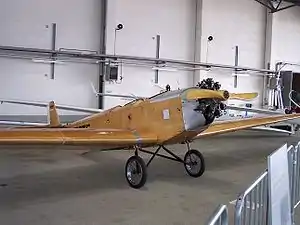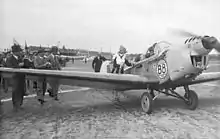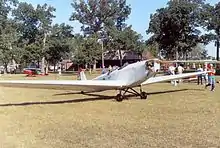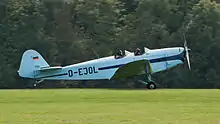Klemm Kl 25
Klemm L 25, later Klemm Kl 25 was a successful German light leisure, sports and training monoplane aircraft, developed in 1928. More than 600 aircraft were built, and manufacturing licenses were sold to the United Kingdom and the United States.
| Kl 25 | |
|---|---|
 | |
| Role | Training plane |
| Manufacturer | Klemm |
| First flight | 1928 |
| Number built | About 720 (including American-built aircraft) |
| Variants | Klemm Kl 26 |


Design and construction
With a low cantilever wing, fixed landing gear, and two open cockpits,[1] the aircraft was developed by Hanns Klemm, who used his previous design, the Daimler L20, as a starting point. It first flew on a 20 hp (15 kW) Daimler F7502 engine.[1] About 30 different versions of the Kl 25 were made, and these were equipped with engines ranging from 32 to 70 kW (43 to 94 hp). The fuselage was covered with plywood.
Depending on the model, the aircraft's weight was 620 to 720 kg (1,367 to 1,587 lb), and it had a 10.5 to 13 m (34 to 43 ft) wingspan. Takeoff was achieved at only 50 km/h (31 mph) and the maximum speed was between 150 to 160 km/h (93 to 99 mph).
In relation to similar aircraft of the time, assembly was very easy, and this made it a very popular aircraft. According to the sales brochures, only 25% of the engine's power was needed to keep the aircraft flying, compared to biplanes of the period, which required 50% engine power.
About 600 were built in Germany between 1929 and 1936,[1] serving with various flight training organizations, with either wheels, skis, or floats.[1] 15 were sold to Britain before the Second World War,[1] being fitted with a variety of domestic engines,[1] while 28 more were built by British Klemm Aeroplane Company as the B.A. Swallow.[1] Production in the United States was carried out by the Aeromarine-Klemm Company which enjoyed moderate success, as well as developing models for the American market, in isolation from the parent company, with about 120 built of all models.
Operation
Klemm L 25s took part in many competitions, among others in International Touring Aircraft Competitions (Europa Rundflug) in 1929 (best 4th place) and in 1930 (best 2nd and 3rd places, L 25E variant).[2]
Variants
- NB, list not complete
 Germany
Germany- L 25 a
- Built between 1927 and 1929, equipped with a 22 PS (21.7 hp; 16.2 kW) Daimler F 7502 engine.
- L 25 I
- Built between 1928 and 1929, equipped with a 45 PS (44.4 hp; 33.1 kW) Salmson AD.9 engine.
- L 25 Ia
- L 25 IW
- Floatplane version of the Ia, with two wooden floats supported by steel-tube struts in inverted 'W' configuration.[3]
- L 25 b
- Built in 1931, equipped with a 22 PS (21.7 hp; 16.2 kW) Daimler F 7502 engine
- L 25 b VII
- Built in 1931, equipped with a 60 PS (59.2 hp; 44.1 kW) Hirth HM 60 engine
- L 25 d II
- Built in 1933, equipped with a 88 PS (86.8 hp; 64.7 kW) Siemens-Halske Sh 13a engine.

- L 25 d VII
- Equipped with a 80 PS (78.9 hp; 58.8 kW) Hirth HM 60R engine (80 PS)
- L 25 IVa
- Equipped with Armstrong Siddeley Genet engine[4]
- VL 25 Va: Three-seater variant, with a closed canopy, equipped with 103 PS (101.6 hp; 75.8 kW) Argus As 8 straight engine[2]
- L 25 Ve
- (see L 25E) For Europa Rundflug 1930
- L 25E
- (L 25 Ve) Special competition variant (E for Europa Rundflug 1930), with a closed canopy, smaller span, equipped with a 103 PS (101.6 hp; 75.8 kW) Argus As 8.[2]
 United Kingdom
United Kingdom- British Klemm Aeroplane Company B.K. Swallow
- British Aircraft Manufacturing Co. B.A. Swallow II
 United States
United States- Aeromarine-Klemm AKL-25
- Aeromarine-Klemm AKL-70
- Aeromarine-Klemm Model 70 Trainer
Operators
Specifications (L 25.Ia)
Data from Jane's All the World's Aircraft 1931[3]
General characteristics
- Crew: 1
- Capacity: 1
- Length: 7.3 m (23 ft 11 in)
- Wingspan: 13 m (42 ft 8 in)
- Height: 1.75 m (5 ft 9 in)
- Wing area: 20.0 m2 (215 sq ft)
- Airfoil: Göttingen 387[5]
- Empty weight: 285 kg (628 lb)
- Gross weight: 500 kg (1,102 lb)
- Fuel capacity: 50 l (13 US gal; 11 imp gal) in aforward fuselsge tank
- Powerplant: 1 × Salmson AD.9 9-cylinder air-cooled radial piston engine, 30 kW (40 hp)
- Propellers: 2-bladed fixed-pitch propeller
Performance
- Maximum speed: 140 km/h (87 mph, 76 kn)
- Landing speed: 50 km/h (31 mph; 27 kn)
- Range: 650 km (400 mi, 350 nmi)
- Service ceiling: 6,500 m (21,300 ft)
- Time to altitude: 1,000 m (3,281 ft) in 8 minutes
- Wing loading: 25 kg/m2 (5.1 lb/sq ft)
- Power/mass: 0.05978 kW/kg (0.03636 hp/lb)
References
- Ketley, Barry; Rolfe, Mark (1996). Luftwaffe fledglings 1935-1945 Luftwaffe training units & their aircraft (1st ed.). Aldershot, GB: Hikoki Publications. p. 12. ISBN 978-0951989920.
- Krzyżan, Marian (1988). Międzynarodowe turnieje lotnicze 1929-1934 (in Polish). Warsaw: Wydawn, Komunikacji i Łączności. pp. 216–218. ISBN 83-206-0637-3.
- Grey, C.G., ed. (1931). Jane's All the World's Aircraft 1931. London: Sampson Low, Marston & company, ltd. pp. 172c–173c.
- Krzyżan, Marian (1988). Międzynarodowe turnieje lotnicze 1929-1934 : Table.II (in Polish). Warsaw: Wydawn, Komunikacji i Łączności. ISBN 83-206-0637-3.
- Lednicer, David. "The Incomplete Guide to Airfoil Usage". m-selig.ae.illinois.edu. Retrieved 16 April 2019.
Bibliography
- Gerdessen, Frederik. "Estonian Air Power 1918 – 1945". Air Enthusiast, No. 18, April – July 1982. pp. 61–76. ISSN 0143-5450.
External links
| Wikimedia Commons has media related to Klemm Kl 25. |